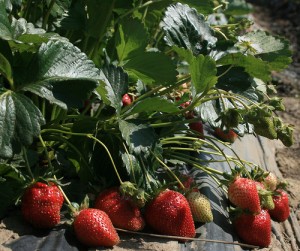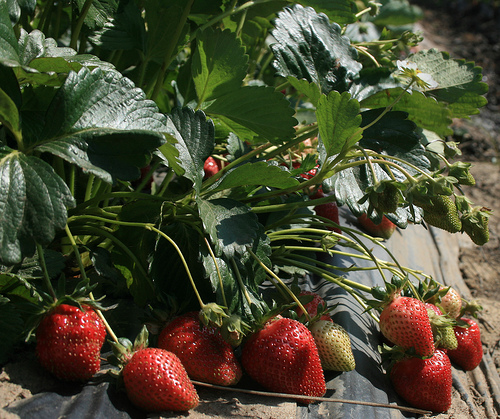 OK folks, I’ll admit it; I certainly thought the shiny red tomatoes and strawberries in the plastic clam shell boxes seemed to taste less and less like those I remember as a kid. I thought it was just the idealistic glow around childhood memories.
OK folks, I’ll admit it; I certainly thought the shiny red tomatoes and strawberries in the plastic clam shell boxes seemed to taste less and less like those I remember as a kid. I thought it was just the idealistic glow around childhood memories.
But no. It turns out that our conventional fruits and vegetables really are losing some of their nutritive value. Does that affect taste? I’m not a food scientist, so I can’t tell you, but they sure taste different to me.
In Not your grandma’s strawberries, Grist‘s Natalie Jones tells us about tests that show those nutrients have disappeared over the last 50 years. Tomatoes and strawberries have lost a number of critical nutrients and tomatoes actually gained a tiny amount of one.
Donald Davis, a scientist retired from the University of Texas at Austin, and his colleagues published a study in 2004 comparing U.S. Department of Agriculture data on vegetable nutrients from 1950 to data from 1999, and found notable decreases, particularly for key nutrients like calcium, iron, phosphorus, riboflavin, and ascorbic acid.
Davis believes that the primary reason for the decrease is selective breeding. As growers and researchers have spent the last 50 years trying to produce varieties of crops that yield more fruit, they’ve been ignoring the effects on nutrient content.
|
Calcium
|
Iron
|
Phosporus
|
Riboflavin
|
Ascorbic Acid
|
|
|
Tomatoes, 1950
|
11 mg
|
0.6 mg
|
27 mg
|
0.04 mg
|
23 mg
|
|
Tomatoes, 1999
|
5 mg
|
0.45 mg
|
24 mg
|
0.048 mg
|
19.1 mg
|
|
Strawberries, 1950
|
28 mg
|
0.8 mg
|
27 mg
|
0.07 mg
|
60 mg
|
|
Strawberries, 1999
|
14 mg
|
0.38 mg
|
19 mg
|
0.066 mg
|
56.7 mg
|
So it looks like organic production of strawberries, at least, brings some of those nutrients back. In fact, recent research* from Washington State University compared side by side plots of organic and conventional strawberries in California. The results:
- Organic strawberries had more dry matter, or, “more strawberry in the strawberry.”
- Organic strawberries had significantly higher antioxidant activity and concentrations of ascorbic acid and phenolic compounds.
- Organic strawberries had longer shelf life.
- The organic soils excelled in a variety of key chemical and biological properties, including carbon sequestration, nitrogen, microbial biomass, enzyme activities, and micronutrients.
- The organically managed soils had dramatically more total and unique genes and greater genetic diversity, important measures of the soil’s resilience to stress and ability to carry out essential processes.
So where do you get fresh strawberries with flavor? Buy organic and buy local. Head out to your local farmers market and run – don’t walk – to the nearest berry vendor and buy organic or transitional berries.
They may not be “perfect,” some may be larger, some smaller, and occasionally even lumpy, but they are definitely REAL strawberries! And there’s nothing more heavenly than fresh ripe strawberries picked just hours before you buy them!
________________________________________
* Fruit and soil quality of organic and conventional strawberry agroecosystems, University of Washington, September 2010

